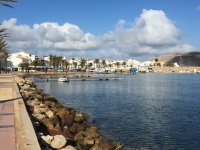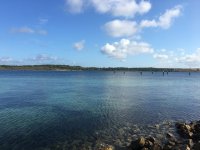Navigation
Install the app
How to install the app on iOS
Follow along with the video below to see how to install our site as a web app on your home screen.
Note: This feature may not be available in some browsers.
More options
-
Ciao Guest - You’ve landed at the ultimate Guzzi site. NEW FORUM REGISTRATIONS REQUIRE EMAIL ACTIVATION - CHECK YOUR SPAM FOLDER - Use the CONTACT above if you need help. New to the forum? For all new members, we require ONE post in the Introductions section at the bottom, in order to post in most of the other sections. ALWAYS TRY A SEARCH BEFORE STARTING A NEW TOPIC - Most questions you may have, have likely been already answered. DON'T BE A DRIVE-BY POSTER: As a common courtesy, check back in and reply within 24 hours, or your post will be deleted. Note there's decades of heavily experienced Guzzi professionals on this site, all whom happily give endless amounts of their VALUABLE time for free; BE COURTEOUS AND RESPECTFUL!
-
There is ZERO tolerance on personal attacks and ANY HYPERLINKS to PRODUCT(S) or other competing website(s), including personal pages, social media or other Forums. This ALSO INCLUDES ECU DIAGnostic software, questions and mapping. We work very hard to offer commercially supported products and to keep info relevant here. First offense is a note, second is a warning, third time will get you banned from the site. We don't have the time to chase repeat (and ignorant) offenders. This is NOT a social media platform; It's an ad-free, privately funded website, in small help with user donations. Be sure to see the GTM STORE link above; ALL product purchases help support the site, or you can upgrade your Forum profile or DONATE via the link above.
-
Be sure to see the GTM STORE link also above for our 700+ product inventory, including OEM parts and many of our 100% Made-in-SoCal-USA GTM products and engine kits. In SoCal? Click the SERVICE tab above for the best in service, tires, tuning and installation of our products or custom work, and don't miss our GT MotoCycles® (not) art on the BUILDS tab above. WE'RE HERE ONLINE ONLY - NO PHONE CALLS MADE OR RECEIVED - DO NOT EMAIL AND ASK QUESTIONS OR ASK TO CALL YOU.
-
Like the new V100, GuzziTech is full throttle into the future! We're now running on an all-new server and we've updated our Forum software. The visual differences are obvious, but hopefully you'll notice the super-fast speed. If you notice any glitches or have any issues, please post on the Site Support section at the bottom. If you haven't yet, please upgrade your account which is covered in the Site Support section or via the DONATE tab above, which gives you full site access including the DOWNLOADS section. We really appreciate every $ and your support to keep this site ad-free. Create an account, sign in, upgrade your account, and enjoy. See you on the road in 2024.
You are using an out of date browser. It may not display this or other websites correctly.
You should upgrade or use an alternative browser.
You should upgrade or use an alternative browser.
Port of Fornells
- Thread starter Robert Gibson
- Start date
Lovely.
Especially so as the VDOT brine & chem trucks are out on our roads here at the top of Virginia as I peck out this envious reply.
Bill
Especially so as the VDOT brine & chem trucks are out on our roads here at the top of Virginia as I peck out this envious reply.
Bill
Lovely.
Especially so as the VDOT brine & chem trucks are out on our roads here at the top of Virginia as I peck out this envious reply..
As frustrating as it is at times to get off the “rock”, especially during the winter months Menorca is a beautiful and largely unspoilt island. It has been my home for the past 16years and I certainly don’t take it for granted.
Anybody out there planning a visit, give me a ping. I’ll be happy to show you around.
It looks like paradise. Not a bad place to call home.
A little more out and about, a distant view of La Mola and the Lazareto.
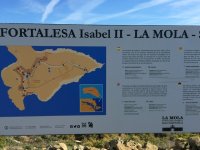

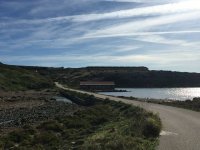
The Lazareto island.


In Great Britain during the XVIII century there was a great deal of concern over the spread of the plague which led to the Quarantine Acts of 1710, 1752 and 1788 being passed by the Government. Britain lost Menorca to the Spanish in 1782 (the end of the second British occupation). It was during this siege that the upper, (above ground), workings of the huge fortress of Sant Felipe were destroyed by the Spanish. The fortress, having been under continuous artillery fire for 29 days with between 80 and 90 shells exploding on the site every hour, almost ended up as a pile of rubble.
In 1787, in the Count of Floridablanca of Charles III of Spain, the Prime Minister gave the order for the construction of such a quarantine station or Lazareto in the Harbour of Mahón. However, the work did not begin until 1793 when the stone from the ruined fortress was put to good use and ferried across the harbour by boat to be recycled and used for much of the construction of the quarantine station. This work was then interrupted by the third British occupation of 1798-1802, but completed in 1807. The Lazareto was finally opened in 1817 and was in full use until 1917.
The design of the complex can be attributed to the Spanish military engineer Manuel Pueyo. The reason for the sheer size of the complex is perhaps better understood from a British parliamentary paper on quarantine of 1861. ”In Spain the only regular lazaret establishments for the admission of foul arrivals are at Vigo and Port Mahón, such arrivals not being admissible into Cadiz, Barcelona, etc.” In fact Port Mahón served the whole of the Spanish Mediterranean seaboard whilst Vigo covered the Atlantic ports.
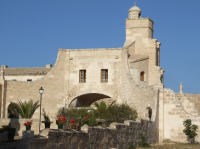
Constructed for complete isolation
Patrick Russell (Treatise of the Plague, 1791), writes “proper lazarettos and quarantines, regularly conducted, are the only means a commercial nation ought to trust in, for preventing the infection of the plague being brought from other countries.” Russell considered a good lazaretto should have one land gate and two water gates and that each water gate have a separate quay, “one for receiving merchandise from the ship, the other for delivering them”. He also writes, “a second wall is sometimes erected, at such a distance from the first as it is impossible to throw any parcel or box”.
In Mahón there are two water gates set far enough apart to be out of site of each other and constructed in two totally different styles so that there could be no confusion. The west gate and main entrance is in the traditional Palladian style, the arched entrance flanked by columns surmounted by two rampant lions supporting the coat of arms. The south gate is in the Luis VI style ornamented above by military trophies. The small land gate at the eastern side is plain in comparison and was of no importance as such, especially after the Sant Jorge canal was constructed in the year 1900, the Lazareto peninsular then becoming an island.
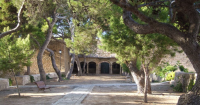
The double walls at Mahón vary between 18ft and 24ft in height and are almost a mile in length. As well as making it impossible to throw objects from inside to outside, or vice versa, the wide corridors formed between the two walls also facilitated the movement of inmates from one area to another in a restricted manner and out of contact with others.
Self Supporting Isolation
The Lazareto is separated into various zones for crews and passengers, those merely suspected of disease and others for those actually infected. There is also the area where the medical and ancillary staff would reside and for food preparation, laundry etc. Fresh water supply was provided by the several wells on the site and vegetables produced in the gardens. Livestock was husbanded in situ and it is said by the locals that some of the finest lamb on Menorca was produced there.
In each zone there are beautifully constructed arcaded warehouses where the ships’ merchandise would be laid out to air and arranged in such a way so that the cargo of each ship was kept separate. Several methods were used to ‘sterilize’ these cargos depending on the type of goods involved. Some were simply exposed to the air, others to the dew and in some cases by fumigation in special smokehouses.
Russell made the point that the superintendent of a Lazaretto should have a house ‘situated to command a view of the whole enclosure’. Here in Mahón’s Lazareto such a building was constructed in the centre of the complex near the eastern wall. It is built on top of high arches with Baroque style sweeping buttresses and, although not a house as such, it was from where the superintendent and his deputies could command the whole operation of the complex. Refurbishment of this beautiful tower is currently in progress.
One of the most interesting and prettiest features of the complex is the chapel. This is like a tiny ‘tempietto’ and is raised on a stepped platform and glazed so that the inmates taking mass had good visibility of the priest across a strip of no-mans land from their surrounding cell-like, open and bar fronted stalls. The inmates being well separated one from the other and in turn well away from the priest and the Holy wine and bread were passed to them on a very long-handled, shovel-like implement so no human contact could be made.
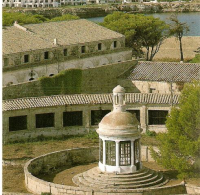
Intrinsic in combatting the spread of deadly diseases
As well as plague, the Lazareto also dealt with yellow fever, cholera and other highly contagious and deadly diseases. The length of quarantine would vary depending of the suspected disease, the part of the world from which the passengers and cargos of the boats originated and also the time of year. An example being that if a ship from the Gulf of Mexico that left in June or July destined for the southern ports of Spain, the time of the year when yellow fever would be most prevalent (later found to be transmitted by mosquitoes), then on arrival at Mahón it would normally be quarantined until November when the cooler weather helped to stop the disease spreading. A winter departure would need less time in quarantine due to the weather being cooler during the passage and less likelihood of the disease surviving. Time of quarantine would vary hugely from just 3 weeks up to 5 or 6 months in some cases.
All captains would leave their ports of origin with ‘papers’ showing that the ship and cargo were suspect and would be denied access to any other port until they had passed through the quarantine process. In Mahón, once the quarantine had been completed and the ship, passengers and cargo were given a clean bill of health the captain would receive a new set of ‘papers’ from the office in Villa Carlos (Es Castell) giving a clear right of passage to any of the mainland European ports. During the 100 years that the complex was in operation (1817 until 1917), over half a million people passed through the gates and several thousand died and were buried in the cemetery, which still exists.
Modern day use
The enormous cost of building Mahón’s Lazareto can perhaps be gauged by the £170,000 spent building the Lazaretto at Chatham in the early 1800’s. The whole complex still belongs to the Spanish Ministry of Health and is used during the summer months as a holiday hotel for health workers and their families. Health related seminars and courses are also frequently held there.
One of the beautiful warehouses is used as a lecture hall and also houses many medical artifacts and implements used during the period, together with copper boilers, fumigators and of great importance one of the very first (and archaic) heart defibrillators produced in Europe. Proudly preserved here, and in mint condition, is the royal barge which carried Queen Isabel II of Spain, rowed by eight Admirals of the Spanish Navy, from Mahón city along the harbour to the Queen’s Steps at La Mola for the Royal inauguration of the fortress named after her in the year 1860.
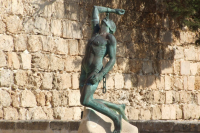
Situated outside the main entrance is a statue off great poignancy. It is of a man rising up and breaking the chains that had restrained him for so long. Engraved on the four sides of the stone plinth are the names of four eminent men of medicine and medical science, of microbiology, of bacteriology and of immunology: Louis Pasteur, (France), Juan Carlos Finlay (Cuban), Sir Alexander Fleming, (Scottish) and Edward Jenner (English).
The mighty mosquito
It was Carlos Finlay who, after years of exhaustive and painstaking studies of Yellow Fever, famously theorised in 1881 that it was a particular specie of mosquito which transmitted the disease from person to person. Some 20 years later, his hypothesis was confirmed by the Walter Reed Commission of 1900. In the words of General Leonard Wood, physician and US Military Governor of Cuba in 1900: “The confirmation of Dr Finlay’s doctrine is the greatest step forward made in medical science since Jenner’s discovery of the vaccination”.
The Mahón Lazareto, during its century of working life, not only helped stem the spread of various dangerous diseases from other continents into Europe, but also dealt with the major outbreaks of Yellow Fever in 1821 and 1870. The quarantine centre was finally closed in 1917, in part due to the availability of new vaccines and medicines, but also because of an invasion of mosquitoes…!!
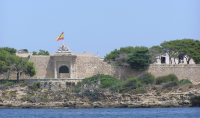



The Lazareto island.


In Great Britain during the XVIII century there was a great deal of concern over the spread of the plague which led to the Quarantine Acts of 1710, 1752 and 1788 being passed by the Government. Britain lost Menorca to the Spanish in 1782 (the end of the second British occupation). It was during this siege that the upper, (above ground), workings of the huge fortress of Sant Felipe were destroyed by the Spanish. The fortress, having been under continuous artillery fire for 29 days with between 80 and 90 shells exploding on the site every hour, almost ended up as a pile of rubble.
In 1787, in the Count of Floridablanca of Charles III of Spain, the Prime Minister gave the order for the construction of such a quarantine station or Lazareto in the Harbour of Mahón. However, the work did not begin until 1793 when the stone from the ruined fortress was put to good use and ferried across the harbour by boat to be recycled and used for much of the construction of the quarantine station. This work was then interrupted by the third British occupation of 1798-1802, but completed in 1807. The Lazareto was finally opened in 1817 and was in full use until 1917.
The design of the complex can be attributed to the Spanish military engineer Manuel Pueyo. The reason for the sheer size of the complex is perhaps better understood from a British parliamentary paper on quarantine of 1861. ”In Spain the only regular lazaret establishments for the admission of foul arrivals are at Vigo and Port Mahón, such arrivals not being admissible into Cadiz, Barcelona, etc.” In fact Port Mahón served the whole of the Spanish Mediterranean seaboard whilst Vigo covered the Atlantic ports.

Constructed for complete isolation
Patrick Russell (Treatise of the Plague, 1791), writes “proper lazarettos and quarantines, regularly conducted, are the only means a commercial nation ought to trust in, for preventing the infection of the plague being brought from other countries.” Russell considered a good lazaretto should have one land gate and two water gates and that each water gate have a separate quay, “one for receiving merchandise from the ship, the other for delivering them”. He also writes, “a second wall is sometimes erected, at such a distance from the first as it is impossible to throw any parcel or box”.
In Mahón there are two water gates set far enough apart to be out of site of each other and constructed in two totally different styles so that there could be no confusion. The west gate and main entrance is in the traditional Palladian style, the arched entrance flanked by columns surmounted by two rampant lions supporting the coat of arms. The south gate is in the Luis VI style ornamented above by military trophies. The small land gate at the eastern side is plain in comparison and was of no importance as such, especially after the Sant Jorge canal was constructed in the year 1900, the Lazareto peninsular then becoming an island.

The double walls at Mahón vary between 18ft and 24ft in height and are almost a mile in length. As well as making it impossible to throw objects from inside to outside, or vice versa, the wide corridors formed between the two walls also facilitated the movement of inmates from one area to another in a restricted manner and out of contact with others.
Self Supporting Isolation
The Lazareto is separated into various zones for crews and passengers, those merely suspected of disease and others for those actually infected. There is also the area where the medical and ancillary staff would reside and for food preparation, laundry etc. Fresh water supply was provided by the several wells on the site and vegetables produced in the gardens. Livestock was husbanded in situ and it is said by the locals that some of the finest lamb on Menorca was produced there.
In each zone there are beautifully constructed arcaded warehouses where the ships’ merchandise would be laid out to air and arranged in such a way so that the cargo of each ship was kept separate. Several methods were used to ‘sterilize’ these cargos depending on the type of goods involved. Some were simply exposed to the air, others to the dew and in some cases by fumigation in special smokehouses.
Russell made the point that the superintendent of a Lazaretto should have a house ‘situated to command a view of the whole enclosure’. Here in Mahón’s Lazareto such a building was constructed in the centre of the complex near the eastern wall. It is built on top of high arches with Baroque style sweeping buttresses and, although not a house as such, it was from where the superintendent and his deputies could command the whole operation of the complex. Refurbishment of this beautiful tower is currently in progress.
One of the most interesting and prettiest features of the complex is the chapel. This is like a tiny ‘tempietto’ and is raised on a stepped platform and glazed so that the inmates taking mass had good visibility of the priest across a strip of no-mans land from their surrounding cell-like, open and bar fronted stalls. The inmates being well separated one from the other and in turn well away from the priest and the Holy wine and bread were passed to them on a very long-handled, shovel-like implement so no human contact could be made.

Intrinsic in combatting the spread of deadly diseases
As well as plague, the Lazareto also dealt with yellow fever, cholera and other highly contagious and deadly diseases. The length of quarantine would vary depending of the suspected disease, the part of the world from which the passengers and cargos of the boats originated and also the time of year. An example being that if a ship from the Gulf of Mexico that left in June or July destined for the southern ports of Spain, the time of the year when yellow fever would be most prevalent (later found to be transmitted by mosquitoes), then on arrival at Mahón it would normally be quarantined until November when the cooler weather helped to stop the disease spreading. A winter departure would need less time in quarantine due to the weather being cooler during the passage and less likelihood of the disease surviving. Time of quarantine would vary hugely from just 3 weeks up to 5 or 6 months in some cases.
All captains would leave their ports of origin with ‘papers’ showing that the ship and cargo were suspect and would be denied access to any other port until they had passed through the quarantine process. In Mahón, once the quarantine had been completed and the ship, passengers and cargo were given a clean bill of health the captain would receive a new set of ‘papers’ from the office in Villa Carlos (Es Castell) giving a clear right of passage to any of the mainland European ports. During the 100 years that the complex was in operation (1817 until 1917), over half a million people passed through the gates and several thousand died and were buried in the cemetery, which still exists.
Modern day use
The enormous cost of building Mahón’s Lazareto can perhaps be gauged by the £170,000 spent building the Lazaretto at Chatham in the early 1800’s. The whole complex still belongs to the Spanish Ministry of Health and is used during the summer months as a holiday hotel for health workers and their families. Health related seminars and courses are also frequently held there.
One of the beautiful warehouses is used as a lecture hall and also houses many medical artifacts and implements used during the period, together with copper boilers, fumigators and of great importance one of the very first (and archaic) heart defibrillators produced in Europe. Proudly preserved here, and in mint condition, is the royal barge which carried Queen Isabel II of Spain, rowed by eight Admirals of the Spanish Navy, from Mahón city along the harbour to the Queen’s Steps at La Mola for the Royal inauguration of the fortress named after her in the year 1860.

Situated outside the main entrance is a statue off great poignancy. It is of a man rising up and breaking the chains that had restrained him for so long. Engraved on the four sides of the stone plinth are the names of four eminent men of medicine and medical science, of microbiology, of bacteriology and of immunology: Louis Pasteur, (France), Juan Carlos Finlay (Cuban), Sir Alexander Fleming, (Scottish) and Edward Jenner (English).
The mighty mosquito
It was Carlos Finlay who, after years of exhaustive and painstaking studies of Yellow Fever, famously theorised in 1881 that it was a particular specie of mosquito which transmitted the disease from person to person. Some 20 years later, his hypothesis was confirmed by the Walter Reed Commission of 1900. In the words of General Leonard Wood, physician and US Military Governor of Cuba in 1900: “The confirmation of Dr Finlay’s doctrine is the greatest step forward made in medical science since Jenner’s discovery of the vaccination”.
The Mahón Lazareto, during its century of working life, not only helped stem the spread of various dangerous diseases from other continents into Europe, but also dealt with the major outbreaks of Yellow Fever in 1821 and 1870. The quarantine centre was finally closed in 1917, in part due to the availability of new vaccines and medicines, but also because of an invasion of mosquitoes…!!



